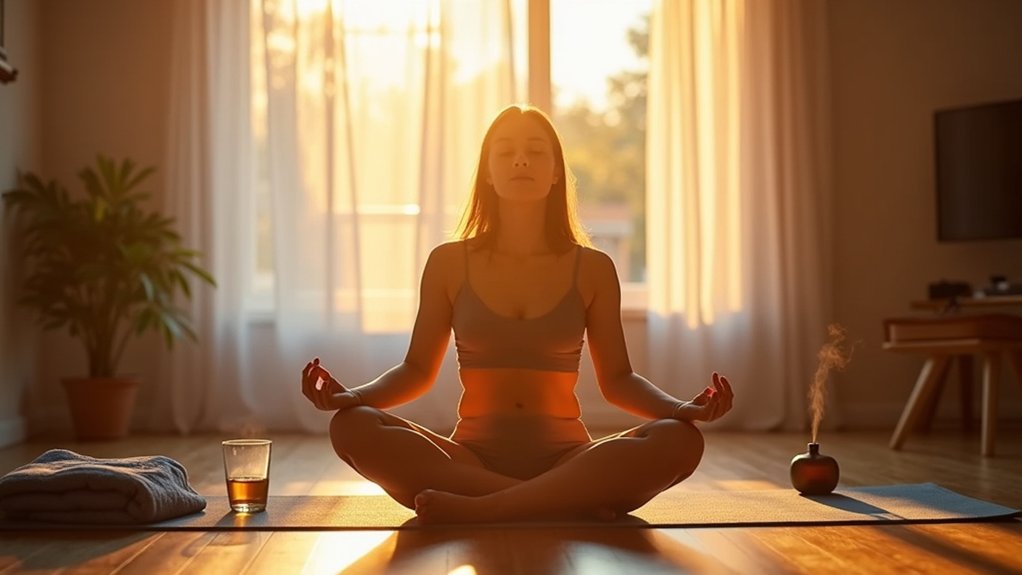
When was yoga developed? A quick look back
Millennia ago, yoga emerged from ancient India’s spiritual roots, blending mind and body—discover how this timeless practice evolved into what we know today.


Managing anxiety often begins with the breath. This overview outlines ten practical mindfulness breathing routines for anxiety, from diaphragmatic belly breathing to structured methods like Box Breathing and the 4-7-8 pattern. It includes balancing techniques such as Alternate Nostril Breathing and calming options like Extended Exhale and Resonant Coherent Breathing. Mindfulness-based practices, including a Guided Visual Breath Scan, Ocean Breath, and a Loving-Kindness focus, add depth. Each method offers a distinct pathway to steadier nerves, supports overall wellbeing and fitness, and encourages consistency in daily practice. Try these mindfulness breathing routines for anxiety during morning workouts, mid-day resets, or evening wind-downs for a quieter mind. With regular use, mindfulness breathing routines for anxiety can help you feel grounded, clear, and in control.

For many experiencing anxiety, diaphragmatic belly breathing offers a simple, evidence-based way to calm the nervous system.
This method emphasizes slow inhalation through the nose, expanding the belly, and relaxed exhalation through the mouth. A hand on the abdomen can guide depth and pace.
Regular practice enhances vagal tone, reduces muscle tension, and stabilizes heart rate variability, supporting steadier attention and emotion regulation during daily stressors or anticipatory worry.
Box breathing, also known as four-square breathing, structures the breath into equal phases to steady physiology and focus attention.
Practitioners inhale for four counts, hold for four, exhale for four, and hold again for four, repeating several cycles. This rhythmic cadence can reduce arousal, slow heart rate, and sharpen concentration.
It is discreet, portable, and useful during meetings, commutes, or transitions, supporting calm without special equipment.
While equal-count patterns like box breathing build steadiness, the -8 Relaxation Breath emphasizes a longer exhale to engage the parasympathetic response.
The practitioner inhales gently through the nose for a comfortable count—often 4—then exhales through the mouth for 8. Shoulders stay relaxed, jaw unclenched, and posture upright.
Practiced for two to five minutes, it can reduce heart rate, soften tension, quiet racing thoughts, and promote emotional regulation.
Though simple in form, Alternate Nostril Breathing (nadi shodhana) balances inhale and exhale through one nostril at a time to steady the nervous system.
The practitioner sits upright, seals the right nostril to inhale left, closes both briefly, then exhales right; reverse to continue.
Even, unforced breaths guide attention, reduce arousal, and promote composure.
Short sessions, two to five minutes, integrate well before meetings or bedtime.
Building on nostril-based pacing, Extended Exhale Breathing emphasizes lengthening the out-breath to activate the parasympathetic response and quiet anxious arousal.
Practitioners inhale gently through the nose, then release more slowly through the mouth or nose, maintaining a smooth, unforced rhythm. A calm posture, relaxed jaw, and soft belly support diaphragmatic control.
Short, consistent sessions help retrain stress reactivity, promoting steadier mood, clearer focus, and improved somatic ease.
Because simple structure can steady a restless mind, Counting Breath Meditation uses gentle numeric cues to anchor attention to inhalations and exhalations.
Practitioners silently count each breath cycle, often from one to ten, then restart. When distraction appears, the count resets without judgment.
This rhythmic tally builds focus, slows breathing, and reduces anxious rumination.
Sessions can be brief, consistent, and adaptable to settings like commutes, breaks, or bedtime.
Trace the breath with the mind’s eye, pairing each inhale and exhale with a calm, sequential scan of the body.
The practitioner observes air enter, notes sensation at nostrils, throat, chest, and belly, then sweeps attention down the shoulders, arms, hands, torso, hips, legs, and feet.
On exhale, the scan ascends. Uncomfortable spots receive gentle notice.
Pace remains even, posture neutral, attention steady.
Wave-like steadiness characterizes Ocean Breath (Ujjayi), a technique that narrows the throat slightly to produce a soft, coastal sound on inhale and exhale.
Practitioners sit or stand tall, seal the lips, breathe through the nose, and gently constrict the glottis. The sound cues pacing, anchors attention, and lengthens exhalation.
This steadies heart rate, reduces sympathetic arousal, and cultivates calm. Beginners maintain comfort, smoothness, and non-strain.
Resonance defines Resonant Coherent Breathing: a steady inhale and exhale of equal length, typically around 5–6 breaths per minute.
This cadence promotes vagal tone, balances autonomic activity, and can reduce anxious arousal. A practitioner sits upright, relaxes the jaw, and breathes nasally, counting an equal 5–6 for inhale and exhale.
A timer or metronome aids consistency. Practice 10 minutes daily for cumulative benefits.
Although gentle in tone, Loving-Kindness Breath Focus is a structured practice that pairs calm nasal breathing with phrases of goodwill to oneself and others.
Practitioners inhale through the nose, lengthening the exhale to settle arousal, while silently repeating intentions like “May I be safe,” then extending them to loved ones and difficult people.
This sequence softens threat perception, reduces rumination, and fosters prosocial emotions that counter anxiety.
These mindful breathing routines offer simple, repeatable tools for easing anxiety and restoring balance. By engaging the diaphragm, extending exhales, or following structured counts, individuals can calm the nervous system and steady attention. Techniques like Alternate Nostril, Ocean Breath, and Resonant Breathing cultivate physiological coherence, while Loving-Kindness and guided scans nurture compassion and presence. Practiced daily or during stressful moments, these methods create a portable refuge—supporting resilience, emotional regulation, and a grounded return to the body and breath.

Millennia ago, yoga emerged from ancient India’s spiritual roots, blending mind and body—discover how this timeless practice evolved into what we know today.

Not only does exercise boost mood through endorphins, but it also combats stress and anxiety—discover the surprising ways it transforms mental health.

Find five powerful benefits of daily meditation that transform your mind and body—discover why this simple habit is truly life-changing.

How do wellness and fitness truly differ, and why does understanding this matter for your holistic health journey? Discover the key distinctions inside.

Increasingly, hobbies are recognized not just for fun but for their profound impact on mental health, personal growth, and social connection—discover why they matter.

Find four powerful ideas to boost your self-esteem and transform your mindset—discover how small changes can lead to lasting confidence and growth.